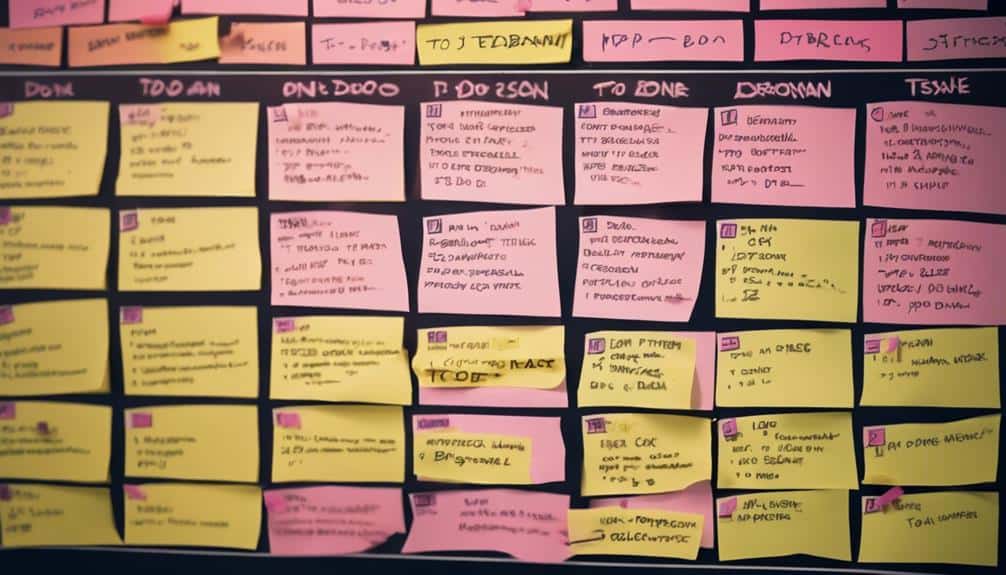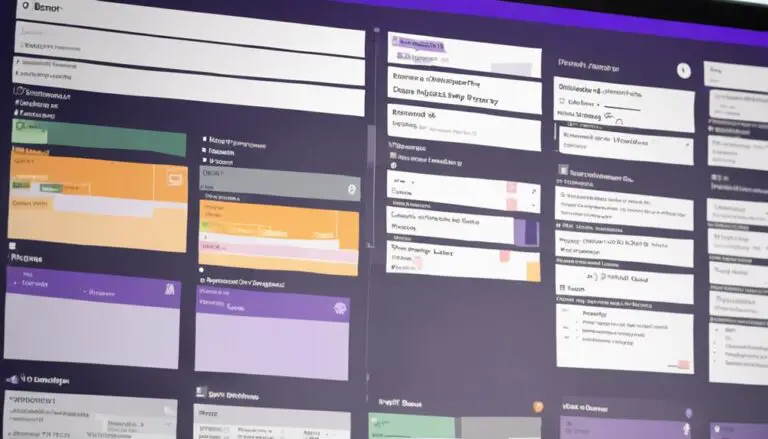Imagine your Scrum process as a highway; the Kanban board acts as signposts guiding your team towards smoother and more efficient project delivery. Understanding how to effectively utilize this tool can significantly boost your team's productivity and collaboration.
By implementing specific strategies and best practices, you can harness the power of the Kanban board to optimize your Scrum process. One such strategy is to limit the work in progress by setting clear guidelines on how many tasks or user stories can be actively worked on at any given time. This helps to prevent bottlenejson and keeps the team focused on completing tasks before moving on to new ones. Another important best practice is to regularly review and update the board to ensure that it accurately reflects the current status of the project. By following these kanban board steps, you can improve the efficiency and effectiveness of your Scrum process.
Key Takeaways
- Enhance workflow visibility and efficiency by utilizing a Kanban board
- Limit work in progress to identify bottlenecks promptly
- Promote shared ownership and collaboration to prioritize tasks effectively
- Improve overall efficiency and streamline operations within the Scrum process
Benefits of Kanban in Scrum
Enhance your Scrum process with the numerous benefits of incorporating Kanban, improving workflow visibility and efficiency. By integrating Kanban into your Scrum framework, you can effectively visualize your workflow, making it easier to track tasks as they progress through different stages. This enhanced visibility not only promotes transparency but also allows for better collaboration among team members.
One significant advantage of Kanban in Scrum is the ability to limit work in progress (WiP). By setting these limits, you can maintain focus, increase productivity, and reduce multitasking, leading to smoother and more efficient project delivery. Moreover, Kanban practices help in identifying bottlenecks promptly, enabling teams to address inefficiencies and optimize their processes effectively.
Through the utilization of Kanban in Scrum, teams can enhance their efficiency and predictability. By leveraging flow metrics like Cycle Time and Work In Progress (WiP), you gain valuable insights that aid in performance evaluation and process improvement. Embracing Kanban within your Scrum methodology can lead to a more streamlined and successful project execution.
Visualizing Work With Kanban
Let's talk about the benefits of visualizing work with a Kanban board and the importance of limiting work in progress.
By visualizing tasks moving through stages, you gain transparency and enhance collaboration within your Scrum team.
Limiting work in progress helps maintain focus, improve efficiency, and prioritize tasks effectively.
Workflow Visualization Benefits
To maximize your Scrum team's efficiency and collaboration, incorporating a Kanban board for visualizing work progress is a valuable strategy. By utilizing task boards within the Scrum framework, you promote shared ownership and enhance the focus on delivering value collaboratively.
The Kanban Method emphasizes enhancing workflow visualization by tailoring it to your team's existing processes. Task boards play a vital role in fostering team collaboration and ensuring shared ownership of tasks, aligning perfectly with the principles of Scrum.
Understanding and applying the six practices of Kanban within the Scrum context are crucial for boosting work efficiency and optimizing your team's performance. Embrace the benefits of workflow visualization to streamline your processes and achieve greater success together.
Limit Work in Progress
By limiting work in progress on a Kanban board, your team can maintain focus on completing tasks efficiently and avoiding the pitfalls of starting too many tasks simultaneously. Setting specific WiP limits ensures a smooth workflow, preventing overwhelming team members with too many tasks at once. Here's why enforcing WiP limits is crucial:
- Enhances Team Focus: Concentrate on finishing tasks rather than juggling multiple tasks simultaneously.
- Boosts Efficiency: Prevents bottlenecks and improves task completion rates.
- Promotes Workflow Stability: Encourages collaboration, reduces multitasking, and ensures a steady flow of work.
Implementing WiP limits on your Kanban board is key to enhancing team productivity and achieving project success.
Limiting Work in Progress
Limiting work in progress on a Kanban board is essential for enhancing team focus and optimizing workflow efficiency. By setting WiP limits, you encourage your team to concentrate on completing tasks before moving on to new ones.
These limits help visualize bottlenecks in your process, allowing for a smoother flow of work. By preventing multitasking, WiP limits reduce context switching and ultimately boost team productivity.
It's crucial for your team to agree on these limits and stick to them to maintain a sustainable work pace and prevent overwhelming team members. Monitoring and adjusting WiP limits based on your team's capacity and identified bottlenecks can lead to more predictable and efficient delivery of work.
Embracing WiP limits not only improves your process but also fosters a sense of cohesion and shared responsibility within your team.
Managing Flow Effectively
When managing flow effectively on your Kanban board, visualizing work progress, limiting work in progress, and tracking cycle time are key points to consider. These practices help streamline your workflow, prevent bottlenecks, and enhance team efficiency.
Visualize Work Progress
To effectively manage flow within your Scrum team, visualizing work progress through task boards is essential. Here are three key ways in which visual representation and task boards play a crucial role in optimizing workflow:
- Enhanced Workflow Visibility: Task boards help in tracking development tasks as they move through different states, providing clear visibility into the progress of each item.
- Promoting Shared Ownership: Evolving task boards encourage shared ownership among team members, fostering collaboration and accountability towards achieving common goals.
- Focus on Delivering Value: By visualizing work progress, teams can focus on delivering value incrementally, a core principle in both Scrum and the Kanban Method.
Limit Work in Progress
Visualizing work progress through task boards is a foundational practice in optimizing workflow within a Scrum team. An integral part of this optimization is managing flow effectively by limiting work in progress. By setting WiP limits on your Kanban board, you help your team focus on completing tasks before taking on new ones, reducing multitasking and improving efficiency.
This approach ensures a smooth and continuous workflow, preventing bottlenecks and fostering collaboration among team members. Monitoring and adjusting WiP limits based on your team's capacity and priorities will further enhance productivity.
Embracing WiP limits not only streamlines your Sprint Backlog but also promotes a more efficient and effective way of working together towards achieving your goals.
Track Cycle Time
Track Cycle Time on your Kanban board to effectively manage flow and optimize your team's workflow. By monitoring Cycle Time, you can enhance efficiency, identify bottlenecks, and achieve predictability in your work delivery.
Here are three key reasons why tracking Cycle Time is crucial:
- Efficiency Boost: Understanding how long work items stay in your process can help streamline workflows and eliminate wasteful steps.
- Identifying Bottlenecks: Monitoring Cycle Time allows you to pinpoint areas where work items tend to get stuck, enabling you to address bottlenecks promptly.
- Continuous Improvement: By tracking Cycle Time regularly, you foster a culture of continuous improvement within your team, leading to sustainable delivery and enhanced productivity.
Making Process Policies Explicit
Ensure that your team's workflow is clear and efficient by explicitly defining the process policies on your Kanban board. Explicit process policies on the Kanban board play a crucial role in managing and tracking work item progress effectively.
By clearly outlining how work items move through stages, these policies address important aspects like hand-offs, unplanned work, and critical requests within the Scrum context. They foster a shared understanding among team members regarding how work flows through the different stages, enhancing transparency and accountability in the workflow.
When everyone is aware of the process policies, it promotes smoother operations and ensures that tasks are completed in a structured manner. This shared knowledge helps in streamlining operations, reducing bottlenecks, and improving overall efficiency.
Therefore, take the time to define and display these policies on your Kanban board to create a more cohesive and productive work environment.
Implementing Feedback Loops
To enhance your team's efficiency and adaptability within the Scrum framework, start implementing feedback loops through regular reviews, retrospectives, and daily stand-ups. By incorporating Kanban cadences, you can ensure continuous improvement and adaptability to meet evolving project needs.
Here are three key practices to help you establish effective feedback loops:
- Service Delivery Reviews: Conducting these reviews allows you to reflect on feedback areas, enhance collaboration, and improve efficiency within your team.
- Sprint Retrospective: Emphasize the importance of inspecting and adapting by leveraging this practice for continuous learning and evolution, fostering a culture of collaborative improvement and experimentation.
- Daily Scrum Meetings: Use these meetings to address any issues that arise, make quick adjustments, and ensure the team is aligned and focused on the sprint goals.
Frequently Asked Questions
How Do I Use Scrum and Kanban Together?
Boost your Agile collaboration with Scrum and Kanban. Streamline visual management, prioritize tasks for team productivity, and enhance workflow efficiency. Continuous improvement aligns Scrum with Lean principles for optimal results.
Can Kanban Board Be Used in Scrum?
Yes, Kanban boards can boost Scrum processes by enhancing transparency and workflow management. They aid in task tracking, prioritize work, and foster collaboration. Integrating Kanban in Scrum promotes agile methodologies and continuous improvement in project management.
What Is the Best Way to Use a Kanban Board?
To use a Kanban board effectively, prioritize visual organization for tracking tasks, managing workflow, and limiting work in progress. Embrace continuous improvement, team collaboration, and transparency for efficiency optimization. It's a tool for success!
When Should You Use Kanban Over Scrum?
When opting for Kanban over Scrum, consider agile practices, project management, team collaboration, workflow visualization, task prioritization, continuous improvement, lean principles, and visual management. Embrace its adaptability for unpredictable workloads and focus on incremental process enhancements.
Conclusion
In conclusion, incorporating Kanban practices into your Scrum process can lead to a more harmonious and streamlined project management experience.
By embracing visualizing work progress, limiting work in progress, managing flow, and making process policies explicit, you can create a more efficient and effective workflow.
Embracing feedback loops further enhances collaboration and adaptability, ultimately leading to more predictable delivery patterns.
Keep up the great work in integrating these valuable practices into your project management approach!





